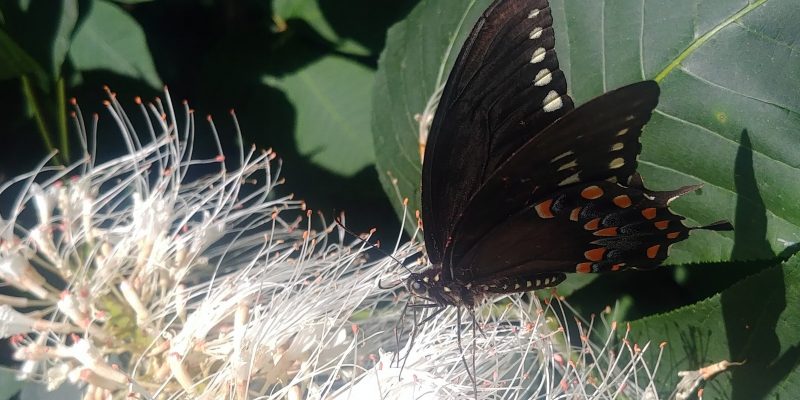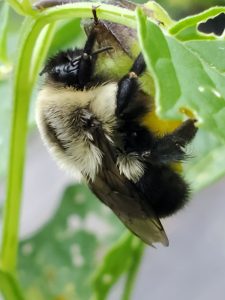
Wallkill Valley Pollinator Pathway: Restoring Habitats for Pollinators…One Backyard at a Time
By José Moreno-Lacalle
From Issue 48: Winter 2021

Common Eastern Bumble Bee on tomatillo flower.
Gardiner residents now have the opportunity to participate in an important movement to save local pollinators while at the same time beautifying their yards and gardens. Here’s how:
The Wallkill Valley Land Trust has created the Wallkill Valley Pollinator Pathway (WVPP). According to its Mission Statement, “Due to the precipitous decline in pollinating insect populations, where 90% of plants rely upon pollinators to reproduce and virtually all songbirds rely on pollinator larvae to feed their young . . . [we] will encourage pollinator awareness in southern Ulster County, New York by:
- establishing a pathway of home gardens and fields planted for pollinators;
- promoting any pollinator projects underway in the region;
- partnering with organizations and municipalities to support pollinators;
- using education and outreach to support this activity.” Consider the following:
Pollinator Decline: Bees, butterflies, and other insects that pollinate our plants, including 30% of our food plants, are in sharp decline due to habitat loss, pesticide use, and climate change. Songbirds, also in sharp decline, are dependent upon pollinator larvae (caterpillars and grubs) to feed their young.
Pathways: To survive, pollinating insects need nectar plants as well as “host” plants for their larvae. Pollinator pathways are simply a series of pollinator-friendly gardens or plantings to help these insects.
By connecting our landscapes and backyards into a corridor of pollinator-friendly gardens within at least a half-mile of each other (the distance many native bees can fly without nourishment) we provide a pathway for pollinators to forage and migrate.
Fields and Byways: Gardiner landscapes already provide many opportunities to support pollinators. Driving down country roads past farm fields one can see all the wonderful wildflowers, many of which were hosting the last generation of monarch butterflies before they migrated to Mexico for the winter.
Native Host Plants: Many of our pollinating insects have evolved to depend on only specific native plants, which are frequently unavailable in conventional landscapes where exotic plant species have become the norm.
For example, the Monarch butterfly depends on milkweed leaves to feed its caterpillars. To save our pollinators, we need to start shifting from traditional exotic landscape plantings to mostly native species for our gardens and landscapes.
Gardiner homeowners with even the tiniest plot are encouraged to join this exciting movement in our region to create a positive environment for the survival of pollinators by planting native species, managing invasive species, avoiding the use of pesticides, especially insecticides, and creating a network with their neighbors of pollinator-friendly pathways.
This is where Gardiner residents can do their part. To help you, WVPP has developed an initial series of services and educational resources on biodiversity and pollinators to support the project:
- selected free recorded webinars;
- books and other publications on biodiversity and pollinators by leading authorities;
- how-to guides on designing, creating and, maintaining pollinator-friendly gardens and meadows;
- local and online native plant and seed sources, native plant lists, and seasonal bloom charts;
- information on invasive species management and effective tick and grub control;
- links to other local and national pollinator websites.
It is also offering a free landscape inventory-analysis site visit by one of our experts to registered members of our pollinator pathway. Monthly updates on WVPP will appear in Wallkill Valley Land Trust’s Field Notes.
Identifying plants and other wildlife including insects can be accomplished by using the iNaturalist identification app (you can download it from the iNaturalist.org Website). It’s a way to actively involve you and the public while raising awareness about the plight of the pollinators.
WVPP has also joined the Northeast Pollinator Pathway (pollinator-pathway.org), an organization of over 100 pathways in New York, Connecticut, and Pennsylvania, and joined the efforts of our neighbor to the north—the Woodstock NY Pollinator Pathway of the Woodstock Land Conservancy (woodstocknypollinatorpathway.org), which embarked on their own pathway early last year and inspired us to do likewise.
The plan is to start small and provide guidance and advice through monthly email updates with pollinator articles. To learn more about the pathway, visit wallkillvalleylt.org/pp.
To join, you must simply commit to the following conditions: Start providing native plants for pollinating insects; begin removing invasive plant species; and avoid using pesticides. For more information contact pollinators@wallkillvalleylt.org.
This is, shall we say, a “win-win” opportunity, which is, beautiful gardens and abundant pollinators!
